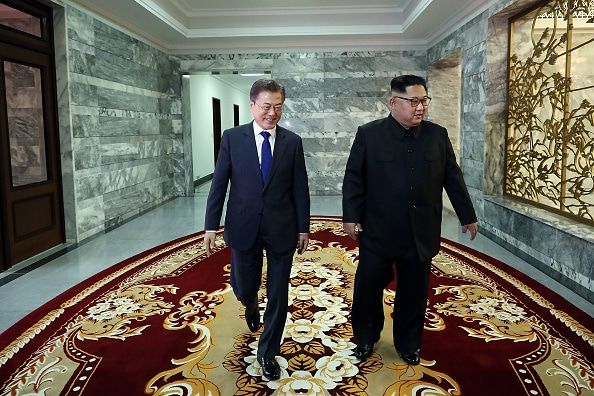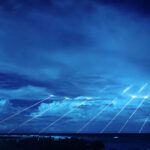Pyongyang Declaration: Bringing peace to the Koreas beyond symbolism
By Duyeon Kim | September 26, 2018
 South Korean President Moon Jae-in, left, walks with North Korean leader Kim Jong-un, right during their meeting on May 2018 in Panmunjom, North Korea.
South Korean President Moon Jae-in, left, walks with North Korean leader Kim Jong-un, right during their meeting on May 2018 in Panmunjom, North Korea.
Symbolism and atmospherics are often just as important as literal deliverables in Korean culture. This symbolic approach is not necessarily understandable to Western minds accustomed to direct, business-like methods. The recent inter-Korean summit in Pyongyang was an example of the importance of the symbolism, atmospherics, and lavish hospitality in the Korean relationship building that often precedes tangible efforts to solve problems. It was clear the two leaders wanted to convey an overarching message of “one Korean race,” and the summit was another opportunity for North Korean leader Kim Jong-un to further build his persona as a normal leader of a normal country. The real-time visuals portrayed the natural affinity all Koreans feel for one another and focused on visions of peace between the two Koreas, while leaving the question of what unification would actually look like open ended.
Symbolism showed many different faces throughout the three days of the summit and in the September Pyongyang Joint Declaration—both of which highlighted aspirational goals, each side’s intentions and shared objectives, as well as contradictions and perhaps even hidden agendas. South Korean President Moon Jae-in and Kim indisputably advanced their April Panmunjom Declaration with more concrete pledges. The pledges were also embedded with symbols of their three main agenda items: reducing military tensions in regard to conventional weapons, improving relations, and addressing, eventually, denuclearization. The two Koreas should certainly make concerted efforts to achieve sustainable peace and deal with conventional military capabilities along the border. But the South Korean public and the international community that have seen this movie countless times before wonder when the gap will finally be closed between symbolism and reality.
The inter-Korean track. In their joint press conference, Moon opened with his version of a symbolic declaration ending the Korean War by vowing to eliminate “all threats;” Kim, meanwhile, stressed the importance for Koreans to band together as “one people” (“uri minjok ggiri”) to overcome challenges and determine their own fate. These tone-setting statements signified the priorities of the two leaders: The Moon administration is determined to declare the Korean War among Seoul, Pyongyang, and Washington over, as a first step and before a signing peace treaty formally ending the war, an idea that first surfaced in 2006. Pyongyang has regularly called on “compatriots of the same blood” to join its revolution against American influence as far back as the early 1960s during Kim Il Sung’s rule.
Moon and Kim’s action items are a reminder that history tends to repeat itself. Because of business left unfinished—including reducing military tensions across the border, improving inter-Korean relations and reuniting the peninsula, and reaching a comprehensive nuclear agreement that finally solves the North Korean nuclear problem—the Korean Peninsula is the land of political replays, despite repeated attempts for decades to finally bring peace to this last relic of the Cold War. Most of the specific actions in the Pyongyang Declaration that might reduce military tensions and improve relations between the North and South trace familiar themes that long-precede the time of Moon and Kim, dating as far back as the 1972 South-North Joint Declaration. Moon and Kim’s renewed efforts to normalize relations are commendable and needed. But those efforts face larger realities: existing sanctions against the North, Pyongyang’s nuclear weapons programs, and the complex geopolitics surrounding different priorities and interests.
In their April 2018 Panmunjom Declaration, the North and South promised to “cease all hostile acts against each other in every domain, including land, air and sea, that are the source of military tension and conflict.” At the latest Pyongyang summit, the two Koreas essentially agreed to take steps toward non-aggression and confidence-building measures for conventional arms control and established a joint military committee. The Koreas made a non-aggression pact and created a joint military commission in their 1992 Basic Agreement, but Pyongyang failed to uphold its commitments. Whether a replay of these efforts can succeed is open to question.
Still, the ability to agree on practical measures during a summit deserves recognition. Their first steps along the border and inside the Demilitarized Zone include: withdrawing some guard posts, creating no-fly zones, halting artillery and other military drills, and demilitarizing the Joint Security Area, a portion of the truce village of Panmunjom where soldiers of both countries face one another at close quarters and where tourists enjoy photo opportunities. However, the two countries’ asymmetric military might—North Korea has nuclear weapons, after all, and South Korea does not (although it does benefit from the US nuclear umbrella)—raises questions about the ultimate objective, parameters, and verification measures for inter-Korean conventional arms control.
The military agreement reached at the latest summit has sparked controversy in Seoul, with many former military generals and defense specialists warning that the proposed no-fly zone, for example, weakens the South’s intelligence, reconnaissance, and surveillance capabilities required to preempt or respond to surprise attacks and long-range artillery fire at Seoul. They argue that the other measures also have implications for transparency, for US forces and assets, and for US-South Korean joint military exercises. For North Korea, the source of “military tension and conflict” is the US presence on and nuclear umbrella over the peninsula. Despite their good intentions, inter-Korean conventional arms control will be difficult to achieve fully without a resolution of the nuclear issue.
The two Koreas also agreed to hold a ground-breaking ceremony that signals the linking of cross-border rails and roads—a key objective for the Moon administration for eventual regional economic integration and South Korean economic development—to resume operations at their joint Gaeseong Industrial Complex located in North Korea, and to again allow tours to Mount Geumgang, a scenic tourist destination, “when conditions are ripe.” But all of these initiatives require the lifting of sanctions on the North—sanctions that are tied to progress on denuclearization. While the two Koreas should work towards peace and reconciliation, moving too quickly on the inter-Korean track could provide disincentives for Pyongyang to seriously commit to the denuclearization process.
The denuclearization track. Symbolism is most detached from intent and scientific reality in the denuclearization components of the Pyongyang Joint Declaration issued last week. But symbolism has also put an ironic twist to Korean negotiations. Exactly 13 years ago, North Korea “committed to abandoning all nuclear weapons and existing nuclear programs” in the September 19th Six Party Talks Joint Statement. This commitment went further than any pronouncements under a Kim Jong-un regime, and at a time when Pyongyang did not have ICBMs, mobile missile launchers, a sizable uranium enrichment program, and the ability to miniaturize a nuclear warhead. Some South Koreans find it meaningful that Kim Jong-un uttered the words “no nuclear weapons, no nuclear threat” in his own voice and agreed to it in writing. But his words actually signify the different definitions that Washington and Pyongyang have as to what “denuclearization” and a “nuclear-free Korean Peninsula” mean.
It remains to be seen how future negotiations will pan out between Washington and Pyongyang, particularly when Moon said he has details to relay to Trump in New York this week regarding Kim’s denuclearization preparedness. But based on public information in the Pyongyang agreement, the Moon-Kim press conference, and Moon’s public debrief, the North has not moved the denuclearization needle forward since the Trump-Kim Singapore summit in June.
One proposed symbolic gesture, already mentioned since the Singapore summit, would have the North abandon the Tongchangri missile engine test facility and launch pad. Last week’s Pyongyang summit added a new step—doing so in the presence of “experts from relevant countries,” apparently Pyongyang’s way of saying “verification” (although North Korea has never welcomed an International Atomic Energy Agency role in the denuclearization process). In its initial proposals related to denuclearization, Pyongyang might be trying to offer facilities that symbolize the regime’s direct threat to the United States: intercontinental ballistic missiles. However, these are not meaningful steps because the facilities in question no longer serve a purpose.
Kim Jong-un proclaimed in December 2017 that his state nuclear force is complete—this means his country no longer needs to test nuclear devices and missiles because self-proclaimed technological mastery now allows Pyongyang to simply mass produce nuclear warheads and ballistic missiles. Also, the regime can still continue to produce ICBMs at other facilities and test engines on mobile launchers, which are of more value to the North. Tongchangri, after all, is home to missiles with liquid fuel engines on static launchers. But Pyongyang has become more interested in mobile launchers and missiles with solid-fuel engines that can be stored, transported, and fired more quickly than liquid-fuel ICBMs, making them harder for the US to preempt.
Pyongyang also says it is “willing to permanently scrap” its Yongbyon nuclear complex—a symbol of its nuclear programs—and take other similar steps “depending on Washington’s corresponding measures.” This proposal suggests the regime is still waiting for Washington to make the first move and implies “corresponding measures” could be the war-ending declaration it has demanded. By mentioning Yongbyon last week, Pyongyang may be suggesting it is willing to offer it—instead of the nuclear inventory Washington wants—as a bargaining chip. Moon’s special advisor outside of government, Professor Moon Chung-in, told JTBC News that Pyongyang does not want to be blamed for cheating or untrustworthiness if it produces a nuclear inventory that differs from US intelligence estimates, so it prefers to declare an end to the Korean War, to build trust, before it hands over an inventory. Although the Trump administration should at least insist on an inventory of all fuel-cycle-related nuclear facilities anywhere in North Korea, even an incomplete list that contains discrepancies would help begin a verification process that can probe for more nuclear sites, weapons, and materials. So when the North finally produces it, the initial nuclear inventory should not be treated as a litmus test for Pyongyang’s seriousness, and if proven flawed, that inventory should not be allowed to break the diplomatic process.
Dismantling Yongbyon would be a meaningful start to a broader dismantlement process because it would constrain some fissile material production. But the value of such a move depends on how “Yongbyon” is defined (scope and specific facilities) and how American negotiators price their bargaining chips. Scrapping Yongbyon may not carry as high a value for the United States as a war-ending declaration does for North Korea. The facilities inside Yongbyon are old, and covert facilities outside the complex will still allow Pyongyang to expand its nuclear arsenal. Dismantling Yongbyon’s old reactors and a reprocessing line there would limit plutonium production, if covert facilities do not exist outside of Yongbyon. The uranium enrichment plant shown to American scientist Siegfried Hecker in 2010 is widely believed to have been built as a bargaining chip to be dealt away in eventual negotiations, while the North retained other, covert uranium-enrichment plants. Under Kim Jong-un, the North Korean regime has been shifting its fissile material production process away from reactors that produce plutonium to a program that enriches uranium via centrifuges, a process that can be hidden more easily than a nuclear reactor.
The two Koreas reached many symbolic agreements last week, but symbolism will not be enough to roll back North Korea’s expanding nuclear arsenal. Summitry with a top-down regime like North Korea can be an effective and historic opportunity, but a second Trump-Kim summit that fails to address denuclearization concretely risks repeating the mistakes of the Singapore agreement, endangering US interests in the region, and changing the future order in Northeast Asia.
Editor’s note: Duyeon Kim’s research is supported by the John D. and Catherine T. MacArthur Foundation.
Together, we make the world safer.
The Bulletin elevates expert voices above the noise. But as an independent nonprofit organization, our operations depend on the support of readers like you. Help us continue to deliver quality journalism that holds leaders accountable. Your support of our work at any level is important. In return, we promise our coverage will be understandable, influential, vigilant, solution-oriented, and fair-minded. Together we can make a difference.
Keywords: North Korea, South Korea, symbolism
Topics: Columnists, Nuclear Risk, Nuclear Weapons
















Were this the Bulletin of just a few decades ago, one would have been surprised to see a purported analysis of the issue of the denuclearisation of the Korean peninsula which, aside from a few mentions of the US «nuclear umbrella» (which, of course, sounds very positive), refrains from mentioning the US as a party to the equation of denuclearisation of the peninsula, as if the DPRK were the Power with military forces there that possessed the largest nuclear aresenal and the most effective means for delivery of such weapons. But alas, with the passing of the old guard, the… Read more »